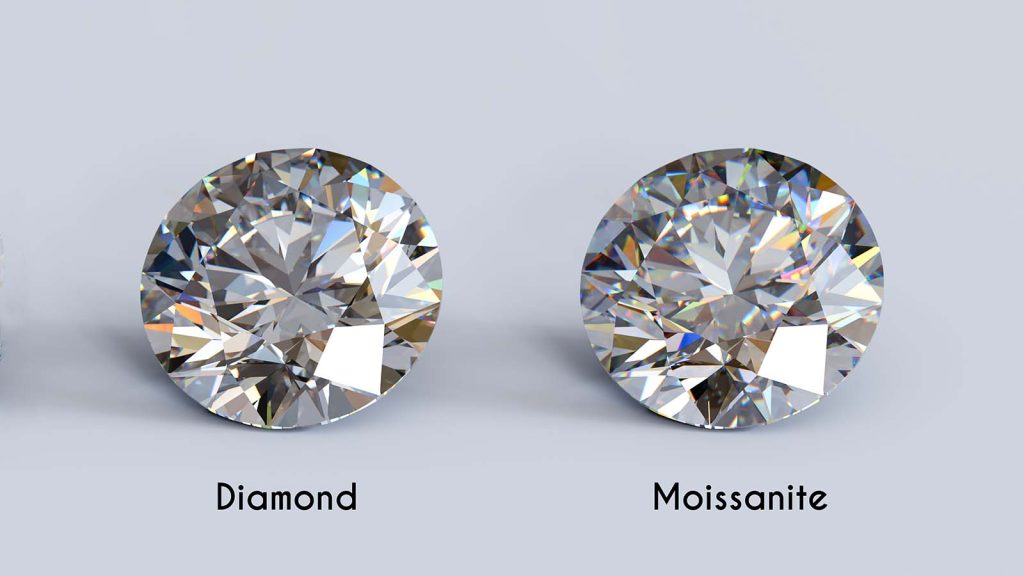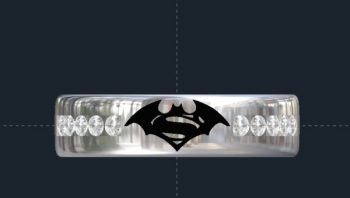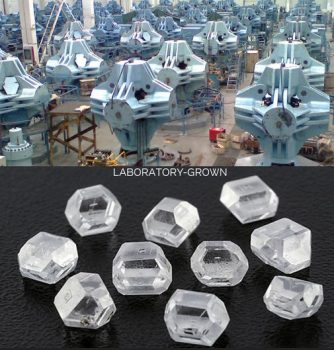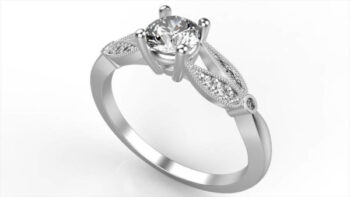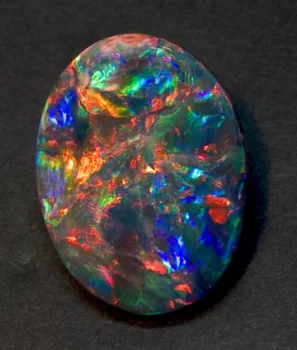We have had people asking us, “What Is Moissanite?” for years now. Well, we will finally write a long overdue post about this beautiful gemstone that is a wonderful alternative to diamonds.
What Is Moissanite?
Moissanite is a gemstone that is gaining popularity as an alternative to diamonds. It was first discovered in 1893 by French chemist Henri Moissan, who found it in a meteorite crater in Arizona. It has a similar appearance to diamonds, with its high refractive index and brilliance. However, it is made of silicon carbide, a compound that is synthesized in a laboratory. This makes it more affordable than diamonds, while still offering a beautiful and durable option for jewelry.
In terms of appearance, moissanite exhibits a stunning brilliance and fire. Its refractive index is higher than that of diamonds, which means it reflects more light and creates more sparkle. This makes it a popular choice for engagement rings and other fine jewelry. Furthermore, it is available in a range of colors, including colorless, near-colorless, and fancy colors such as yellow and green.
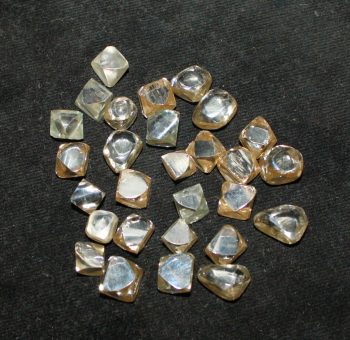
History Of Moissanite
Moissanite is a gemstone that has gained popularity in recent years due to its stunning beauty and affordability. It was first discovered by French chemist Henri Moissan in 1893 while examining a meteorite crater in Arizona. Moissanite is composed of silicon carbide and is known for its brilliance and fire, which rivals that of diamonds. Although initially mistaken for diamonds, it has since become a sought-after alternative for those looking for a more affordable and sustainable option. Its history and origin make it a fascinating gemstone with a unique story to tell.
The discovery of moissanite by Henri Moissan was a significant breakthrough in the field of gemology. Moissan was studying samples from the Canyon Diablo meteorite when he came across a sparkling mineral that he initially mistook for diamonds. Further analysis revealed that this mineral was actually silicon carbide, a compound that had never been found in nature before. Moissan named the mineral after himself to honor his groundbreaking discovery.
Since its discovery, moissanite has been successfully synthesized in laboratories, making it more accessible to the general public. This synthetic gemstone has the same chemical composition and physical properties as natural moissanite, but is created under controlled conditions. This process ensures that the gemstone is free from impurities and flaws, resulting in a high-quality product.
How Is Moissanite Created?
Moissanite is created through a complex scientific process. It starts with a small piece of silicon carbide, which is a naturally occurring mineral. This mineral is then heated to extremely high temperatures, causing it to transform into a crystal structure. The crystal is then cut and polished to create the brilliant gemstone that we know as moissanite. This process ensures that each moissanite stone has the same exceptional clarity and sparkle.
The creation of moissanite involves advanced technology and expertise. The high temperatures used in the process are achieved through specialized equipment and precise control. This ensures that the silicon carbide is transformed into a pure and flawless crystal. The cutting and polishing of the crystal is done with great care to maximize its brilliance and fire.
Moissanite is a popular alternative to diamonds due to its remarkable beauty and affordability. It is a sustainable and ethical choice, as it is created in a laboratory rather than mined from the earth. Its creation also allows for greater control over its quality, ensuring that each stone meets the highest standards. With its stunning appearance and responsible sourcing, it is a gemstone that appeals to those seeking both beauty and conscience.
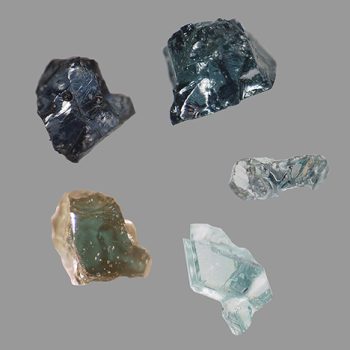
Moissanite Physical & Chemical Properties
Moissanite is composed of silicon carbide, a compound made up of silicon and carbon atoms. This gives it its exceptional hardness, ranking at 9.25 on the Mohs scale, just below that of a diamond. Its refractive index is also impressive, measuring at 2.65-2.69, which means moissanite has a brilliant sparkle. Additionally, it has a high thermal conductivity, making it resistant to heat.
In terms of its chemical properties, moissanite is highly resistant to acids and bases, making it a durable gemstone that can withstand daily wear. It is also resistant to scratching and chipping, making it a popular choice for engagement rings and other jewelry. Furthermore, it is known for its optical properties, such as its ability to disperse light into spectral colors, creating a stunning display of fire.
Overall, moissanite’s physical and chemical properties make it an excellent alternative to diamonds. Its exceptional hardness, refractive index, thermal conductivity, and resistance to acids and bases make it a durable and beautiful gemstone. Whether you’re looking for a unique engagement ring or a stunning piece of jewelry, it is a gemstone worth considering.
Moissanite Pros & Cons
Moissanite is a popular alternative to diamonds due to its affordability and durability. One of its main advantages is cost-effectiveness, as it is significantly less expensive than diamonds. Additionally, it is known for its exceptional hardness, making it resistant to scratches and everyday wear.
Moissanite, while popular as an alternative to diamonds, does have its drawbacks. One of the main cons of moissanite is its lower hardness compared to diamonds. But this is relative. Moissanite is still harder than Ruby or Sapphire. While moissanite is still a durable gemstone, it is not as scratch-resistant as diamonds, which may result in visible wear and tear over time.
Additionally, moissanite has a different optical properties compared to diamonds, which can result in a slightly different appearance. Some people may prefer the unique sparkle of moissanite, but others may find it less desirable compared to the classic brilliance of diamonds. Lastly, moissanite is a synthetic gemstone, which means it is created in a lab rather than naturally occurring. While this may not be a concern for everyone, some individuals may prefer the authenticity and rarity of natural diamonds. It will effect the resale value of the stone though.
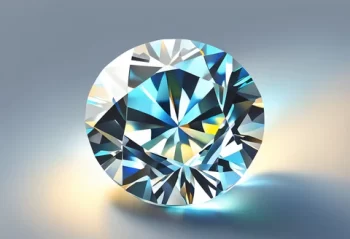
Moissanite Vs Diamond
Price – When it comes to comparing the prices of moissanite and diamonds, there are a few key factors to consider. Moissanite, a lab-created gemstone, is generally more affordable than diamonds. This is because it is produced in a controlled environment, whereas diamonds are mined and can be rare and expensive. Additionally, the its is not influenced by factors such as color or clarity, which can significantly impact the price of diamonds. Overall, if you are looking for a more budget-friendly option without compromising on beauty, moissanite is worth considering.
Clarity – When it comes to clarity, both moissanite and diamond have their unique characteristics. Moissanite is known for its exceptional clarity, with minimal inclusions and blemishes. On the other hand, diamonds are graded based on their clarity using a scale that ranges from flawless to included. While both gemstones can exhibit excellent clarity, moissanite always has VVS to VS clarity. Natural diamonds can be I3, which is basically frozen spit with possible black spots in it.
In terms of clarity, moissanite offers a remarkable alternative to diamonds. With its high clarity rating, it can rival even the most flawless diamonds. This means that moissanite stones are generally free from any visible inclusions or blemishes, resulting in a stunningly clear gemstone.
Color – When it comes to comparing moissanite and diamonds, one aspect that often comes up is color. Moissanite can exhibits a slight yellow or greenish hue, especially in larger sizes. However, this can vary depending on the cut and quality of the stone. On the other hand, diamonds are graded on a color scale from D (colorless) to Z (light yellow or brown). The majority of diamonds used in jewelry fall within the near-colorless to colorless range, making them appear bright and white.
Durability – Diamond is known for its exceptional hardness, scoring a perfect 10 on the Mohs scale. This means that it is extremely resistant to scratches and can withstand everyday wear and tear. On the other hand, moissanite is also quite durable, scoring a 9.25 on the Mohs scale. While not as hard as diamond, it is still highly resistant to scratches and is suitable for everyday wear.
In terms of toughness, both moissanite and diamond are quite strong. Toughness refers to a gemstone’s ability to withstand impact and resist breaking or chipping. While diamond is known for its toughness, moissanite is also a tough gemstone that can handle daily activities without easily getting damaged.
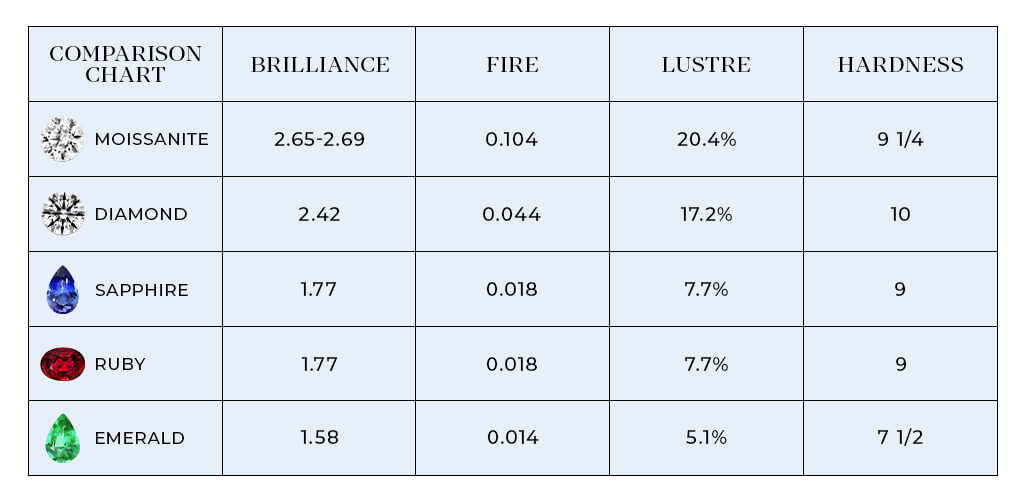
Why Choose A Moissanite Engagement Ring?
When it comes to choosing an engagement ring, many people are opting for diamond alternatives. But why? Well, there are several reasons why moissanite engagement rings are gaining popularity. First and foremost, it is a stunning gemstone that closely resembles a diamond. Its brilliance and fire make it a captivating choice for those who want a ring that sparkles just as much as a diamond, but at a more affordable price. Additionally, it is known for its durability, making it a great option for everyday wear. Finally, it is a more ethical and sustainable choice compared to natural diamonds, as it is created in a lab rather than mined from the earth. So, if you’re looking for a beautiful, durable, and ethical engagement ring, moissanite is definitely worth considering.
We Make Custom Jewelry
Whether you choose diamond or moissanite, it makes no difference to us. We create intriguing rings, custom pendants, etc from the ground up using whatever stones our customers request. Many also ask us, which is better, moissanite or diamonds. The short answer to this question is neither is better than the other. They both serve different needs, wants, and budgets. For some, moissanite is the best option. For others, it isn’t. And this can be for various reasons unique to each person.
So…I guess the next topic to discuss is lab vs natural diamonds!
